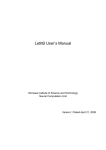Download here - iGEM
Transcript
11/07/2013
Rule-based modelling with
BioNetGen
Workshop Overview
•
•
•
•
•
What is modelling?
Why rule-based modelling?
Deterministic and Stochastic modelling
Michaelis-Menten model
BioNetGen practice
1
11/07/2013
What is a Model?
Taken from the Oxford dictionary:
• A three-dimensional representation of a person or thing or of a proposed
structure, typically on a smaller scale than the original
• A thing used as an example to follow or imitate
• A simplified description, especially a mathematical one, of a system or process, to
assist calculations and predictions
• A person employed to display clothes by wearing them
Source: http://oxforddictionaries.com/definition/english/model, http://commons.wikimedia.org
Modelling in Synthetic Biology
• Modelling traditionally used in biology to
understand and imitate systems
• Synthetic Biology utilizes modelling as a
design to follow
• e.g. Predicting the effect of adding a BioBrick
into our bacteria
2
11/07/2013
Modelling Biological Pathways
Source: http://www.npr.org/blogs/krulwich/2011/09/14/140428189/lord-save-me-from-the-krebs-cycle
Diagrammatic Model
• Useful to visualise the reactions taking place
• Can’t predict what will happen if you change
the reaction conditions e.g. add more of one
reactant
• Can’t predict how the concentration of
molecules will change with time
3
11/07/2013
Mathematical Model
• Predict changes in a system as time progresses
• What can change? Concentrations of…
– Reactants
– Products
– Enzymes
• Which might lead to a change in the rate of
reactions
Mathematical Model
• Often simulated as:
• Ordinary differential equation (ODE)
– Deterministic
• Stochastic
– Non-deterministic
– Random process which evolves in time
4
11/07/2013
Introduction to SBML
• Systems Biology Markup Language
• Often used to write models in synthetic
biology
• Difficult to write from scratch
• A common language for communication
between software packages
What is Rule-Based Modelling?
• Each molecule contains domains that can link
to other molecules
• Complexes are built up by assembly of binding
molecules
• Rules specify which reactions can occur and at
what rate
5
11/07/2013
Why Rule-Based Modelling?
• In modelling, each ‘different
state’ is usually treated as a
separate species
• But with rule-based
modelling you can define a
molecule with multiple states
• This saves time and effort
Sneddon MW, Faeder JR and Emonet T. Efficient modeling, simulation and coarse-graining
of biological complexity with NFsim. Nature Methods (2011) 8(2):177-83.
Michaelis-Menten (MM) Rate Law
• Enzyme + Substrate Enzyme-Substrate Complex
• Enzyme-Substrate Complex Product + Enzyme
• The M-M rate law
• Vmax = k2 (E + [ES])
• KM =
𝑘1+𝑘2
𝑘1
6
11/07/2013
Michaelis-Menten Rate Law
Simple Michaelis–Menten Reaction
<?xml version="1.0" encoding="UTF-8"?>
<!-- Created by BioNetGen 2.2.4 -->
<sbml xmlns="http://www.sbml.org/sbml/level2" level="2" version="1">
<model id="MM-ssa">
<listOfCompartments>
<compartment id="cell" size="1"/>
</listOfCompartments>
<listOfSpecies>
<species id="S1" compartment="cell" initialConcentration="0" name="S(a)"/>
<species id="S2" compartment="cell" initialConcentration="11999" name="E(a)"/>
<species id="S3" compartment="cell" initialConcentration="30099" name="P()"/>
<species id="S4" compartment="cell" initialConcentration="1" name="E(a!1).S(a!1)"/>
</listOfSpecies>
<listOfParameters>
<!-- Independent variables -->
<parameter id="c1" value="0.00166"/>
<parameter id="c1r" value="0.0001"/>
<parameter id="c2" value="0.1"/>
<!-- Dependent variables -->
<!-- Observables -->
<parameter id="Enzyme" constant="false"/>
<parameter id="Substrate" constant="false"/>
<parameter id="Product" constant="false"/>
<parameter id="Complex" constant="false"/>
<!-- Global functions -->
</listOfParameters>
<listOfRules>
<!-- Dependent variables -->
<!-- Observables -->
<assignmentRule variable="Enzyme">
<math xmlns="http://www.w3.org/1998/Math/MathML">
<apply>
<plus/>
<cn> 0 </cn>
<ci> S2 </ci>
</apply>
</math>
</assignmentRule>
<assignmentRule variable="Substrate">
<math xmlns="http://www.w3.org/1998/Math/MathML">
<apply>
<plus/>
<cn> 0 </cn>
<ci> S1 </ci>
</apply>
</math>
</assignmentRule>
<assignmentRule variable="Product">
<math xmlns="http://www.w3.org/1998/Math/MathML">
<apply>
<plus/>
<cn> 0 </cn>
<ci> S3 </ci>
</apply>
</math>
</assignmentRule>
<assignmentRule variable="Complex">
<math xmlns="http://www.w3.org/1998/Math/MathML">
<apply>
<plus/>
<cn> 0 </cn>
<ci> S4 </ci>
</apply>
</math>
</assignmentRule>
<!-- Global functions -->
</listOfRules>
<listOfReactions>
<reaction id="R1" reversible="false">
<listOfReactants>
<speciesReference species="S1"/>
<speciesReference species="S2"/>
</listOfReactants>
<listOfProducts>
<speciesReference species="S4"/>
</listOfProducts>
<kineticLaw>
<math xmlns="http://www.w3.org/1998/Math/MathML">
<apply>
<times/>
<ci> c1 </ci>
<ci> S1 </ci>
<ci> S2 </ci>
</apply>
7
11/07/2013
Simple Michaelis–Menten Reaction
</math>
</kineticLaw>
</reaction>
<reaction id="R2" reversible="false">
<listOfReactants>
<speciesReference species="S4"/>
</listOfReactants>
<listOfProducts>
<speciesReference species="S1"/>
<speciesReference species="S2"/>
</listOfProducts>
<kineticLaw>
<math xmlns="http://www.w3.org/1998/Math/MathML">
<apply>
<times/>
<ci> c1r </ci>
<ci> S4 </ci>
</apply>
</math>
</kineticLaw>
</reaction>
<reaction id="R3" reversible="false">
<listOfReactants>
<speciesReference species="S4"/>
</listOfReactants>
<listOfProducts>
<speciesReference species="S2"/>
<speciesReference species="S3"/>
</listOfProducts>
<kineticLaw>
<math xmlns="http://www.w3.org/1998/Math/MathML">
<apply>
<times/>
<ci> c2 </ci>
<ci> S4 </ci>
</apply>
</math>
</kineticLaw>
</reaction>
</listOfReactions>
</model>
</sbml>
• Writing models by
hand in SBML is
clearly difficult
─ Written for the computer,
not the user
─ Every potential
interaction between
species must be
contained within the
model
Example of a Michaelis-Menten ODE
8
11/07/2013
Michaelis-Menten Simulation
Stochastic Modelling
•
•
•
•
ODE only accurate at high concentrations
Otherwise use stochastic modelling
Quantities expressed as numbers of molecules
Reactions only occur with certain probability
– Because reactions occur when molecules collide
randomly
• Uses stochastic simulation algorithm (SSA)
9
11/07/2013
Stochastic Modelling
• We now deal with integer quantities (of chemical
species) instead of continuous quantities
• X1 + X2 -> X3 (one molecule of X1 plus one molecule of
X2 are transformed into one molecule of X3)
• Let’s simulate one step
X1 = 5
X1= 4
X2 = 5
X2= 4
X3 = 0
X3= 1
• Note: You should avoid using more than 2 reagents in a
reaction e.g. X1 + X2 + X3-> X4
ODE vs SSA
When the number of molecules is
high SSA behaves like ODE(!)
10
11/07/2013
ODE vs SSA
• Deterministic simulation of MM at high
concentrations (E = 2*10-5, S = 5 *10-5)
ODE vs SSA
• Stochastic simulation of MM at high molecule
numbers (start with E = 12 000, S = 36 000)
11
11/07/2013
ODE vs SSA
• Stochastic simulation of MM at low molecule
numbers (E =100, S = 300)
Which Type of Model to Use?
• At low molecule numbers
– use Stochastic model
• At high molecule numbers
– Both types of simulation can be used
– But SSA might require more “computing power”
than the ODE simulation
12
11/07/2013
NFsim
• Complex pathways are
time consuming to
simulate – have to keep
track of every
state/interaction
• NFsim, a BioNetGen addon, runs network free
simulations- only tracks
the existing system
• Much lower runtime
Runtime increases exponentially with
complexity, except for NFsim
Diagram taken from NFsim user manual
Examples
Before going any further into examples, do You
have any questions?
13
11/07/2013
Fundamental Operations BioNetGen
Script is split into ‘blocks’, each defining a different part
of the model
– Parameters: reaction rate constants, and values for initial
concentrations of species in the biological system
– Molecule types: The molecules the model contains, including
their components and allowed component states (e.g.
phosphorylation sites)
– Seed species: The initial state of system (initial species and their
concentrations)
– Observables: The model outputs
Fundamental Operations BioNetGen
Script is split into ‘blocks’, each defining a different part
of the model
– Functions: Define global and/or local functions of observables
for use in rate laws. Not essential.
– Reaction rules: Rules that describe how molecules interact
– Actions: Network generation and simulation
Each block must be enclosed with ‘begin x’ and ‘close x’
where ‘x’ is the block in question (e.g. ‘begin
parameters’ and ‘end parameters’)
14
11/07/2013
Fundamental Operations BioNetGen
• To define a molecule ‘a’ with 2 binding sites:
– a(b,c)
– Where the names of the binding sites are unimportant
• To define a phosphorylation site ‘ps’ on
molecule ‘a’
– a(ps~U~P)
– Where U represents one state (unphosphorylated) and P
represents the other state (phosphorylated)
Fundamental Operations BioNetGen
• To bind molecules ‘a’ and ‘b’, with binding
sites (b) and (a):
– a(b) + b(a) -> a(b!1).b(a!1)
• For the phosphorylation at site ‘ps’ on
molecule ‘a’
– a(ps~U) -> a(ps~P)
– Where molecule a has previously been defined as
a(ps~U~P)
15
11/07/2013
Thank you for your attention
Subtilin production
• Natural antibiotic secreted by B.subtilis in
response to excessive growth
• Lack of food activates:
– Subtilin production
– Immunity of cells
• This system can be modeled using BioNetGen
16
11/07/2013
Subtilin system
33
Modelling
• Not possible to model a population in
BioNetGen
• But there is a way to get around it!
• A set of rules to mimic the effects of the
changes in population can be created
• Set of logical functions is introduced
Example...
34
17
11/07/2013
Single Cell vs Hybrid Models
Single Cell vs Hybrid Models
18
11/07/2013
Hybrid Model
19
11/07/2013
A discrete-time Markov chain
Example of Markov chain
All outgoing arcs must add up to 1
Rate parameter conversion
• Most of the papers use deterministic models
• We might want to convert deterministic model
(ODE) into non-deterministic (Stochastic)
– We would need to convert deterministic rate constants
(the kj’s) into stochastic rate constants (the cj’s)
• First thing to do would be to deal with
concentrations:
– Convert M (moles per litre) into molecule
numbers
20
11/07/2013
Concentrations and molecules
example
• For example let’s try to convert M of the enzyme RibA to
molecules number
• [RibA] = 5 * 10-7 M
• Volume of the cell is V= 10-15 litres
• Number of moles in the RibA enzyme is [RibA]V= 5 * 10-22
• To get number of molecules we need to multiply moles
with Avogadro number nA
nA[RibA]V = nA * 5 * 10-22
Ordinary Differential Equation (ODE)
• It works under three assumptions
1. Reactions always in well-stirred, homogenous
media (mass action kinetics)
2. Quasi-steady state assumption and substrate
>> enzyme (Michaelis-Menten rate law)
3. Concentrations are not small (so we can use
ODE’s)
21
11/07/2013
Stochastic modelling
• The state space of a stochastic model is thus a
set of tuples
• E.g., the state of a 6-species model is a tuple
(x1,x2,x3,x4,x5)
where each xi is a natural number
• In theory, the state space can be infinite (the
number of tuples, not the length of each
tuple)
Stochastic simulation algorithm (SSA)
• Initially developed to analyse and better understand
various chemical reactions which include large number
of species
• Suppose system includes M chemical reactions {
R1,…,RM} and N chemical species
• x(t) = (x1(t),…,xn(t)) is the state vector(number of
molecules of species) of the system at a time t.
• When reaction Rj fires, the system changes as
x(t) -> x(t) + vj
• vj is vector of N integers and represents state change
caused by the firing of Rj
22
11/07/2013
SSA
//initialize time and system state
tsim := 0;
x := x0;
// simulation up to time T
while tsim <= T do
evaluate aj(x) (1 <= j <= M) and a0(x);
t := sample time step from density of Eq.1;
j:= sample reaction index from distribution of Eq.2;
tsim:= tsim + t;
x:= x+ vj;
end
23























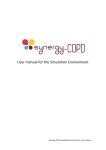
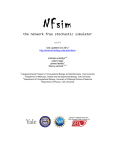

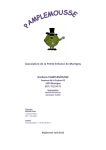


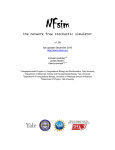


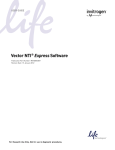
![libsbml[5pt] Developer`s Manual](http://vs1.manualzilla.com/store/data/005677524_1-a4aef53ff9933c16603010582721c07c-150x150.png)
